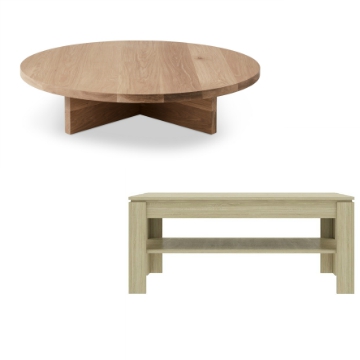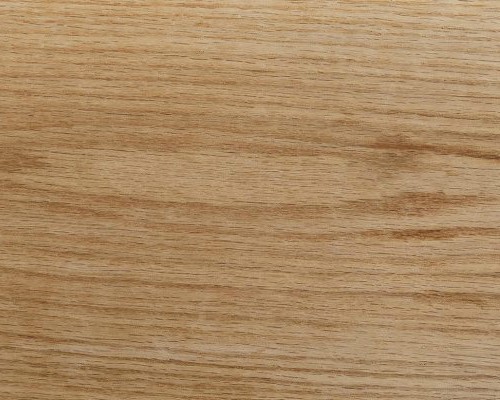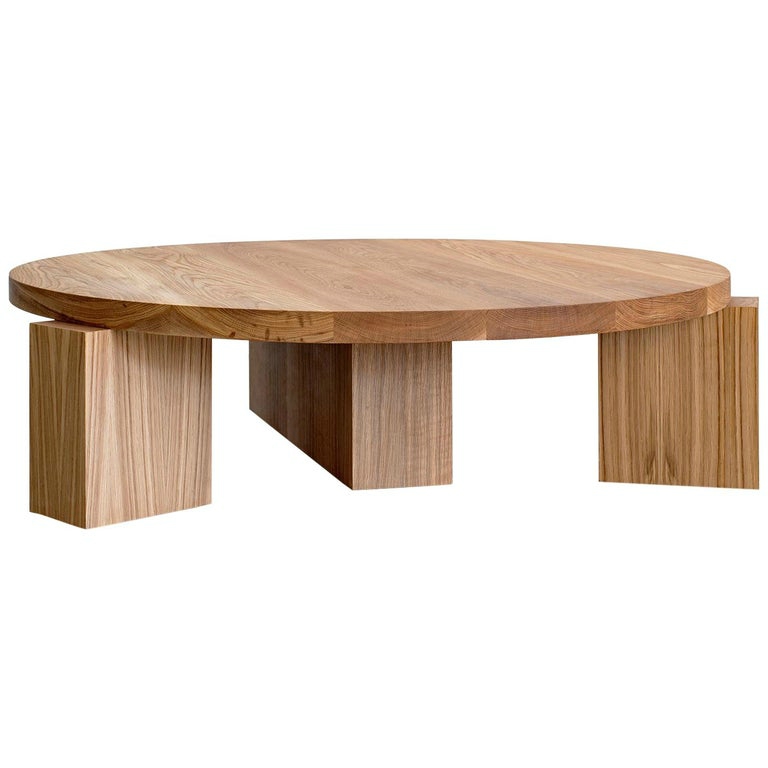How To Tell If A Table Is Solid Oak?

When searching for a solid oak table it can be extremely difficult to differentiate between a real solid oak table and a fake oak table. This has become even more challenging as furniture shopping has increasingly shifted to the internet.
It is not uncommon to spend a large sum of money on what is believed to be a solid oak dining table. Only to be disappointed some months later when one or more of the common signs of fake oak furniture show up. This can be the laminate splitting from the surface, chipping or a scratch exposing the cheap wood or wood-like material which the table is constructed from.
To avoid such a fate when your purchase a solid oak table we have put together a guide for you so you can give yourself the best possible chance of identifying a genuine solid oak table which will be a great investment for years to come.
How To Identify A Solid Oak Table
Below we will detail 9 things to look for when trying to identify whether a table is constructed from solid oak or is in fact an impersonation of the real thing. The more of these characteristics you can confirm the table has the higher the probability you are dealing with a genuine solid oak table.
1. A Solid Oak Table Will Be Considerably Heavier Than A Fake One
The weight of the table is one simple way to distinguish whether a table is in fact made from solid oak or a cheap imposter. If you have two such tables side by side and can lift them the difference in weight will immediately be noticeable.
For example, for the average man a solid oak coffee table will be hard to lift off the floor more than a few inches. Whereas the average man will be able to lift a MDF1 table wrapped in an oak veneer or laminate very easily.
The reason for this is solid oak is much denser than MDF (which is essentially compressed cardboard) or plywood.
2. A Solid Oak Table Will Have Some Variance and Texture To Its Grain
Solid oak is a natural material and any table constructed from oak will contain some variance across its surface. If the surface has not been sealed it will also have some texture. This means when you run your hand over the surface of the table it will not be perfectly smooth.
When assessing whether a table is solid oak this is one of the first tests to carry out. If when you run your hand across the surface of the table it is not perfectly smooth it is a good indication of the table being solid oak.
However, if the surface is not smooth you cannot conclude the table is not solid oak as it may have been sealed.
The next thing you need to do is to inspect the grain of the table. It is helpful to have with you an image showing the grain of solid oak so you can have reference point when assessing the table (if you want you can use the image given below).
If you immediately notice there is no grain to the table you can immediately declare it as not a genuine oak coffee table. It is most likely a laminate made to look like oak wrapped over a table constructed in MDF of plywood.
But, if there is a grain to the table you need to further analyse it. What you need to look for is whether the grain varies across the surface of the wood or whether it is the same graining pattern repeated consistently. If the graining pattern shows now variance it is probably a veneer.
If you have identified a variance across the surface of the table it is a positive indicator the table is solid oak.

3. The Underside Of A Solid Oak Table Will Be The Same Colour As The Top Side
In most cases a solid oak table will be the same colour on the table top and the underside. The only exception to this may be if the top-side has been finished with a sealant such as Danish Oil and the bottom has not. If this is the case though the wood will not look markedly different.
When you look at the underside of the table if the type of wood is completely different to the top side it is likely you are dealing with a laminate or veneered piece of wood. It is not uncommon to see MDF or plywood2 used on the underside of a fake solid oak table.
If you do spot an underside to a table advertised as a solid oak table which is completely different to the surface you can safely arrive to the conclusion it is not an oak table.
And if you see the colour on the underside of the table is the same as the top side of the table this is another positive indicator you are dealing with solid oak.
4. A Solid Oak Table Will Have No Laminate Wrap Around It
Solid oak has inherent natural beauty and has no need to imitate itself with a cheap laminate wrapped around it. If you identify a laminate wrap around an oak table it is a certain sign the table is not solid oak.
Laminate is normally a type of vinyl or plastic used to wrap around MDF board or plywood to give the illusion of solid wood. There is nothing wrong with this if the table is not being marketed as solid oak. However, a laminate table will have far shorter life span and not possess the natural beauty of genuine oak. So how do you identify a laminate wrap?
As mentioned above no grain in the surface of the table is a clear sign the table is wrapped with a laminate. Another indicator of a laminate wrap is a smooth surface (although a solid oak table may sometimes have a smooth finish, a laminate wrap will always have a smooth finish).
In person, a laminate table imitating solid oak will look cheap and tacky. This will be even more apparent if you look at a laminate table next to a genuine solid oak table. However, when shopping online it may be hard to identify the difference between genuine solid oak and a laminate imitation.
For this reason, we advise you to consider all the factors we have detailed in this guide before purchasing a table online. This way you give yourself the maximum probability of purchasing a genuine solid oak table.
5. A Solid Oak Table Will Cost Significantly More Than Imitations
The cost of a table can give you a good idea as to whether a table is constructed from solid oak or not. Although there are people who dishonestly price an imitation table as if it were a genuine one, this is quite a rare occurrence. What you should be looking for is a table priced so low that it cannot possible be constructed from solid oak.
In nearly all cases a genuine solid oak table will be priced in the thousands of pounds (as a guide a solid oak coffee table will be at least £2,500). If the price is lower than this you are very likely not dealing with a solid oak coffee table. The only exception is if the table is constructed form oak strips glued together (we will go through this in more detail later in this guide).
So why does a solid oak table cost significantly more than an imitation?
This comes down to simple economics, a genuine solid oak table will cost more than laminate or veneered imitations. The cost of the raw material for a solid oak table far exceeds that of a laminate or veneered table which is normally constructed from MDF board (compressed cardboard) or plywood.
A solid oak table will need to be constructed by a skilled craftsman. This obviously increases the cost of production due to the increased labour costs, as skilled labour is expensive. Not only does the skilled labour cost more for a genuine solid oak table, but it takes longer to construct. Again, this further increases the price.
If you compare this production process with that of a laminate or veneered table which is mass produced normally in a country with low labour costs such as China. You can immediately see how the price of each type of table can differ greatly.
It is important to look at the value you get from each type of table. On a price per year basis solid oak tables are normally far cheaper as they can last for generations. Not to mention the superior beauty, durability and craftsmanship.
When it comes to assessing if a table is genuine solid oak, price is a key indicator. If the price is in the hundreds it is very likely you are not looking at a genuine solid oak table.
6. Solid Oak Tables Can Be Carved, Laminate and Veneered Tables Cannot
If you see any form of carving on a table this is a big indicator that it is solid oak. If a laminate or veneered table is carved the core wood (MDF or Plywood) would be exposed.
Obviously, some solid oak tables will not possess carvings. But, if you do see carvings this rules out that the table is veneered or laminated and conclude the table is constructed from some form of hardwood.
7. The Lead Time For Solid Oak Tables Are Normally Longer
Due to the economics of constructing a genuine solid oak table, they are quite often made to order. The result of this is a longer lead time from order to delivery. Although some luxury furniture companies may keep a small number of oak tables in stock it is unlikely they will always have every variety of solid oak table in stock.
Whereas companies which are selling laminate or veneered tables will hold large quantities in stock as their business model will revolve around importing large quantities of tables from China to get them at a low unit price to maximise their profits.
So, if you see a lead time of 6-8 weeks it is a good indicator you are dealing with a solid oak table.
8. The Supplier Is Willing To Give You Written Confirmation Your Table is Genuine Solid Oak
If you are unsure whether the table you are thinking of purchasing is genuine solid oak, a great way to protect yourself is to ask the supplier to provide you written confirmation that the table is solid oak.
At Prestige Edition, we are happy to provide written confirmation on the origin and authenticity of all our items. And any supplier who is selling the exact material advertised should be happy to do this.
If you are giving written confirmation that the table you are looking at is genuine solid oak this is a highly positive indication of the table being authentic. And of course, if written confirmation is not given this is a big red flag.
9. The Way in Which The Table is Joint Together
Even if the table you are looking at shows all the indications mentioned above of being a genuine solid oak table there is one more important thing to consider. This is the way in which the table top wood is bonded.
This can be an area of great confusion as it allows suppliers to legally market the table as a piece of solid oak furniture but not mention it is made up of thin strips, blocks or staves of oak glued together under pressure.
These pieces of wood are normally 4 centimetres in width and up to 30 centimetres long. This process makes the oak table a lot cheaper than using genuine new pieces of oak as it makes use of unwanted pieces of woods referred to as off-cuts. And of course, the finish is not as aesthetically pleasing as you do not get the flow of the oak grain3.
A genuine solid oak table will have minimal joints to maximise the beauty of the wood. You will normally see some joints on luxury furniture but on occasions you will see a table top constructed from one piece of wood (the use of one piece of wood is governed by the width of the tree).
The joints on a piece of luxury furniture will be minimised as the table will be constructed from new slabs of wood. Joints will only be used where two pieces of wood are joined together. Obviously using new wood makes the table more expensive as opposed to gluing unwanted offcuts together (you can see a luxury solid oak coffee table in the image below).
The type of oak used is another extremely important factor to consider when purchasing a solid oak table. It is a matter of opinion whether unwanted offcuts glued together should be classified as solid oak. But the difference in beauty between this method and using new pieces of solid oak is not in question.
If you consider the factors mentioned above when looking for a solid oak table you will maximise your chances of purchasing a genuine solid oak table. If you would like to explore a comprehensive range of genuine solid oak tables you can click on the link below:
Solid Oak Coffee Table Collection

Products in this Material